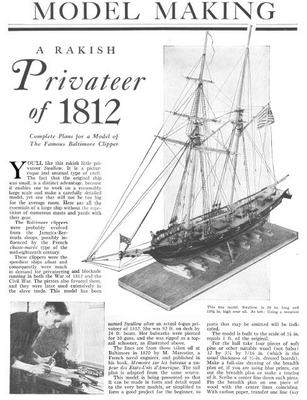Sold by pdfs4you on Tradebit
The world's largest download marketplace
3,250,280 satisfied buyers
The world's largest download marketplace
3,250,280 satisfied buyers

ARTS AND CRAFTS MODEL SHIP BUILDING
TO BUILD THIS VINTAGE 1812 SAILING SHIP PICTURED
AROUND 15 PAGES !! PRINTABLE !!
SOME EXCERPTS OF DOCUMENT FIST PARAGRAPH AS FOLLOWS:
Complete Plans for a Model of The Famous Baltimore Clipper. Youll like this rakish little privateer Swallow. It is a picturesque and unusual type of craft.
The fact that the original ship was small, is a distinct advantage, because it enables one to work on a reasonably large scale and make a carefully detailed model, yet one that will not be too big for the average room.
Here are all the essentials of a large ship without the repetition of numerous masts and yards with their gear.
The Baltimore clippers were probably evolved from the Jamaica-Bermuda sloops, possibly influenced by the French chasse-maree type of the mid-eighteenth century.
These clippers were the speediest ships afloat and consequently were much in demand for privateering and blockade running in both the War of 1812 and the Civil War.
The pirates also favored them, and they were later used extensively in the slave trade.
This model fine model, Swallow, is 20 in. long and 13,1/4 in. high over all.
Using a template named Swallow after an actual 6-gun privateer of 1812. She was 92 ft. on deck by 24 ft. beam. Her bulwarks were pierced for 10 guns, and she was rigged as a topsail schooner.
The lines are from those taken off at Baltimore in 1820 by M. Marestier, a French naval engineer, and published in his book, Memoire sur les bateaux a vapeur des Etats-Unis dAmerique.
The sail plan is adapted from the same source. This model is being presented so that it can be made in form and detail equal to the very best models, or simplified to form a good project for the beginner, so parts that may be omitted will be indicated.
The model is built to the scale of in. equals 1 ft. of the original.
For the hull take four pieces of soft pine or other suitable wood (not balsa) 12 by 3Vi. by 7/16 in. (which is the usual thickness of V2-in. dressed boards).
Make a full-size drawing of the breadth plan or, if you are using blue prints, cut out the breadth plan or make a tracing of it.
Scribe a center line down each piece. Pin the breadth plan on one piece of wood with the center lines coinciding. With carbon paper, transfer one line , ETC ETC ETC
This article goes on and on thanks for reading !!!
File Data
This file is sold by pdfs4you, an independent seller on Tradebit.
| File Size | 33 megabytes |
| File Type |
